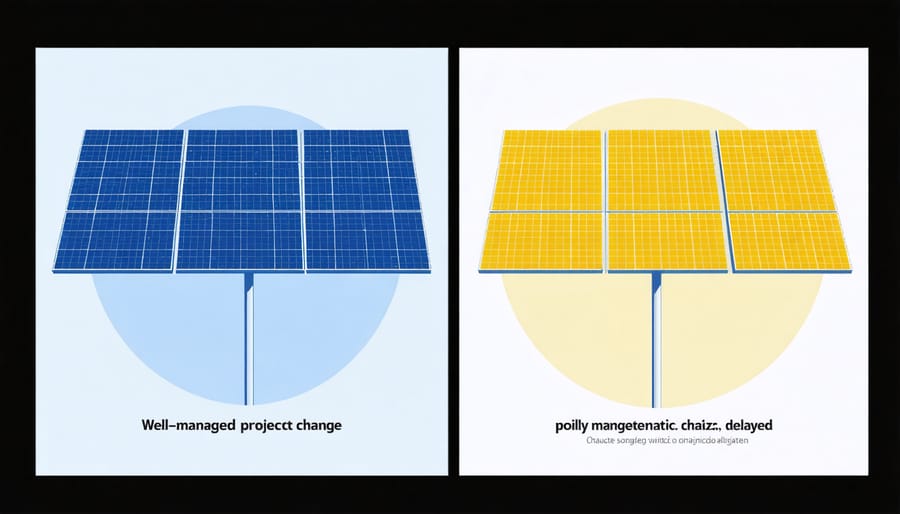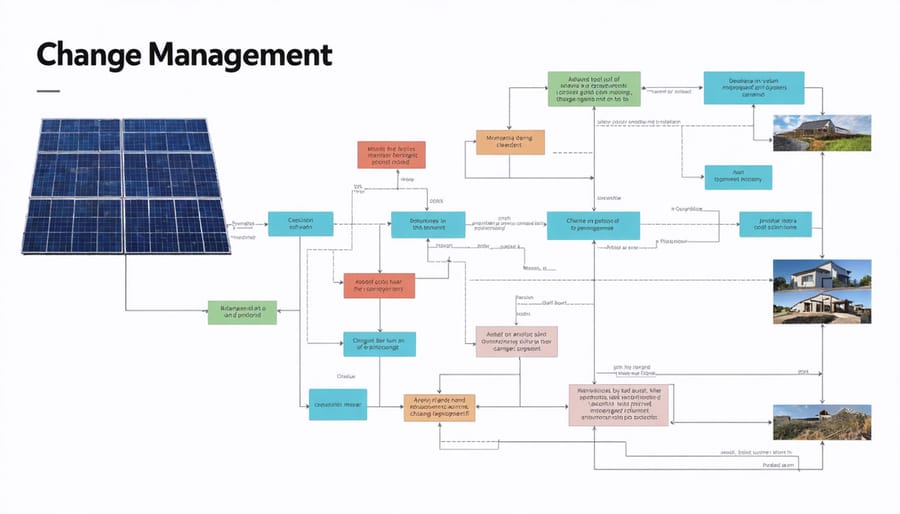How Smart Change Management Keeps Your Solar Project on Track (Even When Plans Shift)

Transform project changes from potential disruptions into strategic advantages through successful solar project management practices that anticipate and adapt to evolving requirements. Managing change in modern projects demands a sophisticated balance between flexibility and control, particularly in Europe’s rapidly evolving renewable energy sector.
Effective change management requires three critical components: a robust change control system that captures and evaluates modifications, a transparent decision-making framework that engages all stakeholders, and an agile implementation process that maintains project momentum. Project managers must develop these systems before project initiation, not as reactive measures.
The financial impact of poorly managed changes can cascade throughout the project lifecycle, affecting everything from timeline adherence to resource allocation. Studies indicate that projects with structured change management protocols are 75% more likely to meet their objectives and stay within budget constraints. This systematic approach transforms potential disruptions into opportunities for innovation and process improvement.
By establishing clear change thresholds, documentation requirements, and approval pathways, organizations create a foundation for sustainable project success. This proactive stance ensures that changes enhance rather than derail project outcomes, maintaining both stakeholder confidence and operational efficiency throughout the project lifecycle.
Why Solar Projects Need Robust Change Management
Common Change Triggers in Solar Projects
Solar projects frequently encounter change triggers that require careful management and swift adaptation. Weather conditions often necessitate timeline adjustments, particularly in European regions with variable climates. Technical developments, such as the introduction of more efficient solar panels or innovative mounting systems, can prompt mid-project modifications to enhance overall system performance.
Regulatory changes, including updates to feed-in tariffs, grid connection requirements, or building codes, commonly drive project adjustments. Supply chain disruptions affecting component availability or pricing may force alterations to equipment specifications or delivery schedules. Site-specific challenges, discovered during detailed surveys or installation, might require modifications to the original design or mounting configuration.
Customer requirements can evolve during implementation, especially in larger installations where business needs may shift. Grid operator requirements or connection policies might change, necessitating system modifications. Additionally, technological advances in energy storage solutions or monitoring systems could present opportunities for project enhancement that stakeholders wish to incorporate.
These changes, while challenging, often lead to improved project outcomes when managed effectively through established change control processes.

The Cost of Poor Change Management
Poor change management in solar projects can lead to significant financial and operational consequences. When changes aren’t properly controlled and documented, projects often experience cost overruns, delayed timelines, and reduced system performance. Studies indicate that inadequately managed changes can increase project costs by 15-40% and extend completion times by up to several months.
The ripple effects extend beyond immediate financial impacts. Uncontrolled changes can compromise system quality, leading to reduced energy generation capacity and higher maintenance costs throughout the installation’s lifetime. Additionally, poor documentation of changes can create compliance issues with local building regulations and energy standards, potentially resulting in costly retrofits or legal complications.
Team morale and stakeholder relationships also suffer when changes aren’t properly managed. Confusion about current specifications, rework requirements, and unclear responsibilities can lead to frustrated installers and unhappy clients. This often results in damaged professional relationships and lost future business opportunities.
Most importantly, inadequate change management can compromise safety standards and system reliability, potentially leading to warranty disputes and increased liability risks for installation companies.
Building Your Change Management Framework

Change Assessment Protocols
Effective change assessment in project management follows a structured protocol to evaluate and implement modifications while maintaining project integrity. Begin with a formal change request documentation that clearly outlines the proposed modification, its rationale, and initial resource implications.
The assessment process starts with impact analysis across five key dimensions: schedule, budget, scope, quality, and risk. Project managers should quantify potential effects using standardised evaluation matrices and consult with relevant stakeholders, including technical experts and financial controllers.
Create a detailed evaluation report that includes:
– Direct and indirect costs associated with the change
– Timeline implications and potential delays
– Resource availability and allocation requirements
– Technical feasibility assessment
– Risk analysis and mitigation strategies
– Compliance with regulatory requirements
Establish clear acceptance criteria for evaluating changes, considering both immediate project objectives and long-term operational benefits. Involve key stakeholders in the review process through structured feedback sessions and documentation of concerns.
Priority classification helps manage multiple change requests effectively. Use a three-tier system:
– Critical: Immediate attention required, affecting project viability
– Important: Significant impact but not time-critical
– Optional: Beneficial but not essential for project success
Remember to maintain a comprehensive change log and ensure all assessments are documented with clear reasoning for approval or rejection. This creates an audit trail and helps inform future decision-making processes.
Stakeholder Communication Strategies
Effective communication forms the cornerstone of successful change management in solar project implementation. Following established stakeholder communication best practices ensures smooth transitions and maintains project momentum. Begin by identifying all stakeholders and their preferred communication channels, from site owners to regulatory bodies and installation teams.
Create a structured communication plan that outlines the frequency, format, and content of updates for each stakeholder group. Regular progress reports should highlight achieved milestones, upcoming changes, and potential impacts on project timelines or deliverables. Utilize a mix of communication methods, including formal documentation, digital platforms, and face-to-face meetings, to maintain engagement and ensure message clarity.
Transparency is crucial when communicating changes. Present both challenges and solutions clearly, focusing on how modifications benefit the project’s overall objectives. Establish feedback channels that allow stakeholders to voice concerns and contribute insights. This two-way communication approach helps build trust and promotes active participation in the change process.
Document all communication efforts and maintain an accessible repository of project updates, decisions, and modifications. This creates an audit trail and serves as a valuable reference point for future phases of the solar installation project, ensuring continuity and alignment among all parties involved.
Documentation and Tracking Systems
Effective change management relies heavily on robust documentation and tracking systems that provide transparency and accountability throughout the project lifecycle. For solar installation projects, implementing a structured change request system is essential for maintaining control and ensuring successful outcomes.
A comprehensive change management system typically includes digital platforms that capture and track change requests from initiation through implementation. These systems should document the proposed change, impact analysis, cost implications, and timeline adjustments. Modern project management software solutions offer integrated change tracking features, allowing teams to maintain detailed records while automating workflow processes.
Key components of an effective documentation system include:
• Standardised change request forms
• Impact assessment templates
• Change approval workflows
• Implementation tracking tools
• Cost and schedule variance logs
• Stakeholder communication records
For European solar projects, documentation must align with regional regulations and standards while maintaining clear audit trails. Digital systems should enable real-time status updates and generate reports for stakeholder reviews and compliance purposes.
Regular system audits ensure that all changes are properly documented and tracked, with clear visibility of approval status and implementation progress. This systematic approach helps project managers maintain control while providing stakeholders with accurate, up-to-date information about project modifications and their impacts.
Remember to maintain historical records of all changes, as they provide valuable insights for future projects and help teams develop more accurate planning estimates for similar installations.
Implementing Changes Successfully
Risk Mitigation Strategies
Effective risk management strategies are essential for minimizing disruption during change implementation in solar energy projects. Start by conducting thorough impact assessments to identify potential risks and their consequences on project timelines, resources, and stakeholder relationships.
Establish clear communication channels and protocols to ensure all team members and stakeholders remain informed throughout the change process. This includes regular updates, feedback mechanisms, and dedicated points of contact for addressing concerns promptly.
Create detailed contingency plans that outline specific responses to anticipated challenges. These should include alternative suppliers for solar components, backup installation teams, and flexible scheduling options to accommodate weather-related delays or regulatory changes.
Implement a phased approach to change implementation, allowing for careful monitoring and adjustment at each stage. This method helps contain potential issues within smaller, manageable segments of the project rather than affecting the entire implementation simultaneously.
Consider establishing a change control board comprising key stakeholders to evaluate and approve proposed changes. This ensures that modifications align with project objectives and maintain quality standards while minimizing unnecessary disruptions.
Document all changes and their outcomes thoroughly, creating a valuable reference for future projects and continuous improvement. This documentation should include successful mitigation strategies, lessons learned, and best practices specific to solar energy installations.
Invest in team training and development to build change management capabilities across the organization. Well-prepared teams are more resilient and better equipped to handle unexpected challenges while maintaining project momentum.
Timeline and Resource Adjustment
When changes occur in solar installation projects, adjusting timelines and resources becomes crucial for maintaining project momentum. The key lies in developing flexible scheduling approaches that can accommodate modifications while keeping the project on track towards completion.
Start by conducting a comprehensive impact assessment of the proposed changes. This involves evaluating how timeline adjustments will affect resource availability, including skilled installers, equipment, and materials. Create a detailed resource reallocation plan that accounts for both immediate and downstream effects of the changes.
Implement a rolling wave planning approach, which allows for detailed short-term planning while maintaining flexibility for longer-term activities. This method is particularly effective in solar projects where weather conditions and regulatory approvals can introduce unexpected delays.
Utilise resource levelling techniques to optimise workforce distribution across modified project phases. This might involve redistributing installation teams between multiple sites or adjusting equipment delivery schedules to align with new timeline requirements.
Consider establishing resource buffers – additional time or personnel capacity that can be deployed when changes threaten project deadlines. These buffers should be proportional to the project’s complexity and risk profile.
Regular monitoring and reporting mechanisms are essential for tracking the effectiveness of timeline and resource adjustments. Implement weekly progress reviews to ensure modified schedules remain realistic and resource allocation remains optimal.
Remember to communicate all adjustments clearly to stakeholders, particularly when changes affect project milestones or delivery dates. This transparency helps maintain trust and ensures all parties can align their expectations with the updated project timeline.

Measuring Change Management Success
Measuring the success of change management initiatives requires a systematic approach combining quantitative metrics and qualitative assessments. By tracking project performance metrics before, during, and after implementing changes, organizations can evaluate the effectiveness of their change management strategies.
Key Performance Indicators (KPIs) for change management typically include:
• Schedule adherence: Measuring the impact of changes on project timelines
• Budget variance: Tracking cost implications of implemented changes
• Stakeholder satisfaction rates: Gauging acceptance and support levels
• Implementation efficiency: Monitoring the speed and smoothness of change adoption
• Quality metrics: Assessing the impact on deliverables and outcomes
• Resource utilization: Evaluating the effectiveness of resource allocation
Successful evaluation methods combine these hard metrics with softer measures such as team morale, communication effectiveness, and stakeholder engagement levels. Regular pulse surveys and feedback sessions can provide valuable insights into how well changes are being absorbed and implemented across the organization.
For solar energy projects, specific attention should be paid to:
• Technical performance indicators post-change implementation
• Impact on installation efficiency and quality
• Customer satisfaction levels
• Regulatory compliance maintenance
• Supply chain adaptability
• Team productivity and capability development
It’s essential to establish baseline measurements before implementing changes and conduct regular assessments throughout the change process. This enables organizations to identify trends, address issues promptly, and demonstrate the value delivered through change initiatives.
Organizations should also consider long-term sustainability metrics to ensure changes create lasting positive impact rather than temporary improvements. This includes monitoring ongoing adherence to new processes, sustained performance improvements, and the organization’s enhanced capability to handle future changes effectively.
Effective change management remains a cornerstone of successful project delivery in the solar energy sector. By implementing robust change control processes, maintaining clear communication channels, and fostering stakeholder engagement, project managers can navigate modifications while keeping initiatives on track. The key to success lies in anticipating potential changes through thorough planning and risk assessment, coupled with maintaining flexibility to adapt to evolving project requirements. Remember that change management is not merely a reactive process but a proactive strategy that should be integrated into every phase of your project lifecycle. When properly executed, it becomes a powerful tool for ensuring project success, maintaining timeline integrity, and delivering optimal results for sustainable energy implementations across Europe. Moving forward, organizations that embrace systematic change management approaches will be better positioned to achieve their project objectives while maintaining stakeholder satisfaction.
Leave a Reply